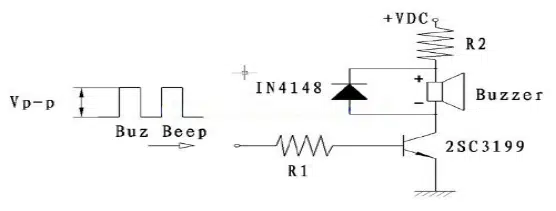How to Test Electromagnetic
Transducer without Test Equipment
The electromagnetic transducer is cost-effective and customizable, which is very popular for many designs. Today we will talk about how to test an electromagnetic transducer without test equipment.
Circuit Parameters
Take a finished PCB, or there is a buzzer tone output part of the complete circuit of the PCB piece.
Then confirm if the circuit parameters of the PCB are correct without test equipment as below.
Check if the circuit amplifier part is correct. Refer to the attached Figure 1, where the diode IN4148 can be without.

Figure 1
Oscillation Frequency
Check whether the frequency of the signal generated on the PCB matches the selected buzzer. The signal frequency should preferably be 50% duty cycle square wave, otherwise, it will affect some of the parameters of the buzzer. The rated frequency of the selected buzzer must be the same as the actual frequency of use or ahead of it. And pay attention not to select a buzzer with a backward frequency.
For example, if the output frequency of your PCB is 2700Hz, you must select a buzzer with a rated frequency of 2700Hz or 2600Hz. Never choose a buzzer rated above 2700Hz. Most buzzers are generally used between 100-200Hz. So it is also best not to choose a buzzer rated before 2600Hz.
Power Consumption
Check that the power of the signal source on the PCB is sufficient to saturate the buzzer amplifier part of the triode, such as not enough must be adjusted to reduce the resistance of R1 in Figure 1, R2 resistance must be less than the resistance value of the buzzer or 0 ohms
Rated Voltage
Check that the voltage of the amplifier part of the buzzer on the PCB matches the rated voltage of the selected buzzer. Too small a voltage will make the parameters of the buzzer fail to meet the specifications.
Lead the wire from the part of the PCB where the buzzer is connected to the test fixture. Be careful not to connect the positive and negative poles wrongly. The electromagnetic passive buzzer has clear positive and negative poles, not to be connected wrongly.
If you don’t have a sound pressure meter, you can use the smallest standard seal to compare the volume and identify it by listening to the sound. Because the human ear will be fatigued when listening to the sound for a long time and there will be greater deviation when listening to the sound in a fatigued state. So this way of testing will be more controversial. It is better to use a sound pressure meter.
That’s the way we can test magnetic transducers without equipment. In a word, we’d better to test with professional devices in order to get accurate test results.



